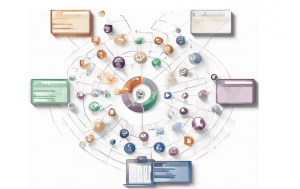Choosing a Requirements Traceability Tool: A Brief Guide
In software development the effective management of requirements is a important aspect of successful outcomes. Managing clear, concise, and error-free requirements is a task that requires a good requirements management tool. This post aims to guide you through the process of selecting a Requirements Traceability tool that will streamline your requirements management and set your project up for success.
Understanding Requirements Management and Traceability
Requirements management is the process of collecting, analyzing, refining and prioritizing the needs of different stakeholders in a system. These needs could relate to functionality or technical requirements. The goal is to ensure the delivery of high-quality products by eliminating ambiguity and ensuring all requirements are met.
Requirements traceability, a sub-discipline of requirements management, ensures that the defined requirements are duly tested and linked at every point during the verification process. It provides forward and backward visibility into all activity surrounding each requirement, including design, development, testing, and support. This visibility provides greater control over project scope, manages changes more effectively, and ensures compliance standards are met.
The Need for a Requirements Traceability Tool
Traditionally, requirements management and traceability were handled manually using tools like Microsoft Word or Excel. However, these general-purpose tools lack many essential features needed for efficient requirements management and traceability.
Furthermore, as software development projects become increasingly complex, the need for specialized tools to manage requirements has become more important. These tools not only streamline the management process but also automate many of the tasks involved, significantly reducing the risk of errors and improving productivity.
Key Features to Look for in a Requirements Traceability Tool
When selecting a requirements traceability tool, consider the following key features:
1. Support for Different Methodologies
The tool should have the flexibility to support various software development methodologies, providing the ability to adapt to your specific process.
2. Traceability
The tool should provide end-to-end traceability, allowing you to link requirements to tests, code, builds, and other development activities.
3. Collaboration
The tool should facilitate collaboration among team members, streamlining the sharing of requirements and discussions.
4. Import/Export Feature
The tool should enable the importing and exporting of requirements from various platforms like MS Excel, MS Word, and other Requirements Management (RM) tools.
5. Version Control
The tool should provide a way to track changes to requirements over time, allowing you to see who made changes and when they were made.
6. Security
The tool should ensure the security of your data, preventing unauthorized access and information leaks.
7. Requirements Reusability
The tool should allow for the reuse of requirements that have been used before in previous projects, promoting productivity and consistency throughout the project.
Evaluating and Comparing Requirements Traceability Tools
There are many requirements traceability tools available in the market. Each tool has its own strengths and weaknesses. Therefore, it’s crucial to evaluate and compare different tools based on your specific requirements and needs.
Here are the key factors to consider:
1. Ease of Use
The user interface should be intuitive, and the learning curve should be short.
2. Integration
The tool should seamlessly integrate with other tools in your development ecosystem, such as project management tools, issue trackers, and document repositories.
3. Reporting
The tool should provide flexible and customizable reporting, including requirements traceability reports.
4. Cost
The cost of the tool is also a major consideration. Some tools are more expensive than others, but they may also offer more features and capabilities.
5. Customer Support
The tool provider should offer responsive and effective customer support to assist you with any issues that may arise.
Top Requirements Traceability Tools
When it comes to requirements traceability tools, DOORS, Jama Connect, codeBeamer, and DOORS Next are all valuable options that cater to different needs. Let’s compare and contrast these tools, highlighting the strengths of DOORS and DOORS Next along the way.
IBM Engineering Requirements Management DOORS:
Strengths: IBM DOORS has long been a trusted leader in the field of requirements management. It offers robust capabilities for end-to-end traceability, enabling teams to link requirements to tests, code, builds, and other development activities. Its rich feature set, including version control and security, ensures data integrity and compliance. IBM DOORS is known for its usability and adaptability to various software development methodologies.
Jama Connect®:
Strengths: Jama Connect excels in providing a collaborative platform for teams to manage requirements. It offers features for capturing, analyzing, and prioritizing stakeholder needs effectively. While it supports traceability, it may not provide the same level of integration and adaptability as IBM DOORS.
codeBeamer:
Strengths: codeBeamer is an integrated Application Lifecycle Management tool that covers the entire software product development process. It offers end-to-end traceability and collaboration features, making it suitable for comprehensive project management. However, it may lack some of the specialized features of IBM DOORS in the context of requirements management.
IBM Engineering Requirements Management DOORS Next:
Strengths: DOORS Next, also offered by IBM, builds on the legacy of IBM DOORS with enhanced capabilities. It combines the strengths of traditional requirements management with modern features. DOORS Next provides a user-friendly interface, making it easy for teams to adopt. It’s highly adaptable to different methodologies and offers robust traceability features.
IBM DOORS and DOORS Next stand out in several ways:
Comprehensive Traceability: Both IBM DOORS and DOORS Next offer end-to-end traceability, allowing teams to link requirements to various development artifacts. This depth of traceability is critical for managing complex projects.
Integration: IBM DOORS and DOORS Next seamlessly integrate with other tools in the development ecosystem, ensuring a smooth flow of information across the project. This integration capability is crucial for efficient project management.
Reporting: Both tools provide robust reporting features, including requirements traceability reports. These reports offer valuable insights into project progress and compliance.
IBM Engineering Global Configuration Management (GCM). IBM’s GCM capability significantly enhances the value of IBM DOORS and DOORS Next, setting them apart from competitors like Jama Connect and codeBeamer in several key ways:
- With IBM Engineering GCM, users can manage configurations of requirements and associated artifacts systematically. This means you can create and manage multiple baselines, snapshots, or variants of your project’s requirements and related documents. This is crucial for complex projects that require versioning and configuration management.
- Jama Connect and codeBeamer offer some level of version control and configuration management, but they do not provide the same level of granularity and sophistication as IBM Engineering GCM. This can be a limitation for organizations with complex product lines or compliance requirements.
- The GCM capability ensures that traceability links are maintained across different configurations. This means you can track how changes in one configuration affect others and maintain end-to-end traceability even in complex, multi-variant projects.
- Jama Connect and codeBeamer offer traceability features, but managing traceability across multiple configurations can be challenging, especially when dealing with extensive sets of requirements. IBM Engineering GCM simplifies this process.
- GCM supports better risk mitigation and compliance management by providing a clear view of the configuration state at any given time. This is especially important for industries with stringent compliance requirements, such as automotive (ISO 26262) and aerospace (DO-178C).
- Jama Connect and codeBeamer tools can help manage compliance to some extent, the comprehensive configuration management offered by IBM Engineering GCM adds an extra layer of assurance.
Conclusion
Effective requirements management is crucial for the success of any software development project. The right requirements traceability tool can drastically streamline this process, saving time, reducing errors, and improving productivity. When selecting a tool, consider its ease of use, integration capabilities, reporting features, cost, customer support, and the key features it offers. By carefully evaluating and comparing different tools, you can choose the one that best fits your specific needs and requirements.
Adopting a requirements traceability tool is a strategic investment that can significantly impact the success of your software development projects. By choosing the right tool, you can ensure that your projects are set up for success from the start, allowing you to deliver high-quality products that meet all stakeholder requirements.
About 321 Gang: We work with enterprises to accelerate the engineering and development of large, engineered systems. 321 Gang Consultants work with the industry-leading system builders of embedded software on best practices for requirements management, model-based systems engineering (MBSE), test management/verification and validation, and traceability for compliance and reporting. Visit our website or contact us to learn how we can improve your traceability capability.

321 Gang | 14362 North FLW | Suite 1000 | Scottsdale, AZ 85260 | 877.820.0888
